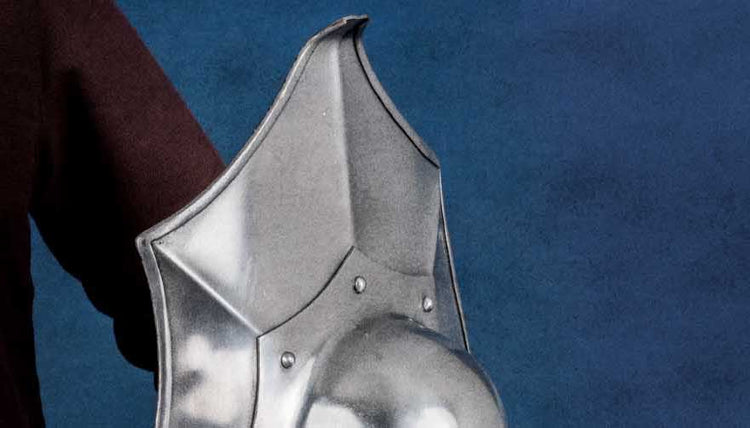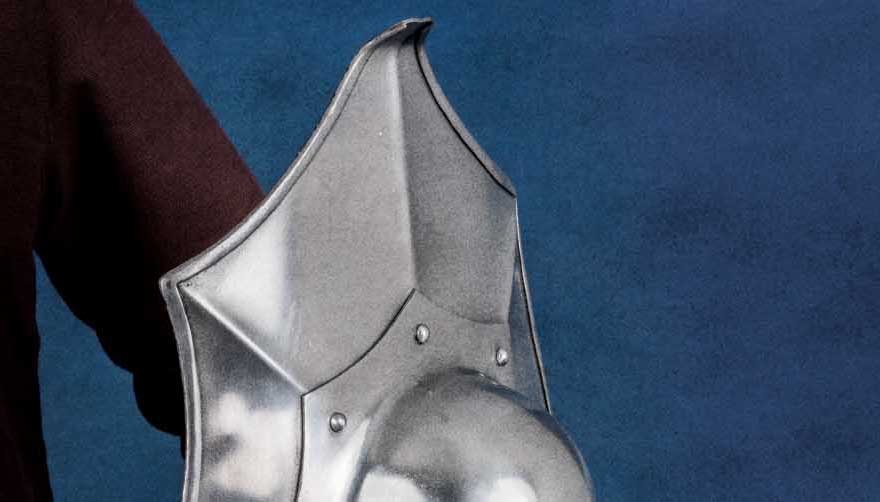Shields
In pictures and movies depicting historical battles, one piece of equipment used by knights and soldiers is indispensable: the shield. Even modern task forces, such as riot police, use shields in the field as a protective weapon and tactical tool. Additionally, we also encounter the shield again and again in everyday life: as a coat of arms. Families as well as cities, municipalities, and military units use shields to symbolize their historically evolved significance.
The invention and use of the shield for protection in battle follow a logical realization: if the protection worn on the body is not sufficient to intercept the destructive effect of the opponent's weapon, the most effective alternative is to stop the weapon before it hits the body. This is precisely the purpose of a shield.
Held protectively in front of the body, it is suitable as a protective surface against impact weapons, stabbing weapons, as well as arrows, bolts, or projectiles. At the same time, the opponent can be kept at a distance with a shield. Used as a tactical element, we also know the shield from depictions of battles in which ranks of foot soldiers use their large shields together as a protective wall, which is to stop attacking troops and, for example, provide hidden archers an opportunity to attack the enemy.
Over the centuries, the shield has changed again and again in structure, material, shape, and size, depending on its purpose, but has never lost its basic function.
10,000 Years of Protection - The Development of the Shield
Even the ancient Egyptians and Sumerians used cloth-covered wicker and later leather-covered wooden frames as simple shields.
In ancient times, shields made of metal or metal-reinforced wood became increasingly widespread. Metal-covered edges and a hump of metal gave the shield of wood additional resistance and also served to shape it in a way to better deflect blows.
Smaller shields were also made entirely of metal. Far more resistant and durable, their size was, however, significantly limited by the weight of the material.
Small shields, however, had the distinct advantage of not overly hindering their wearer. A clear disadvantage of a shield, which at least in individual cases could cancel out the value of its protective effect and made it not useful for every warrior, was the fact that it took up one arm. Two-handed weapons could not be used in this way. For example, for archers, shields were ultimately excluded from consideration, and a two-handed sword could not be combined with it. For the fight with the one-handed sword, the spear, or even in the tournament with lances, shields were the perfect complement.
The development of the shield ran parallel to the development of the weapons it protected against. Over the years, a greater variety can be seen in design and size. Generally known, for example, are the large, wooden tower shields of the Romans, which were also used to form protective walls in battles.
Round shields in various sizes were already used by the Vikings.
The small buckler, ultimately the independent variant of the shield hump common in large shields, was able to prove itself as a fist shield through simple handling and its diverse protective effect. From the significantly larger dragon shield, the triangular shield was developed, which is still found today as a classic shield form used in coats of arms.
In addition to their very practical protective effects, at least since the Middle Ages, shields also bore symbolic significance. Shields were decorated with individual symbols of rulership. After the battle, they served to carry loot or even dead from the field. On the grave slabs of important commanders and rulers, as well as in medieval literature, they still help historians today identify the depicted persons without any doubt.
With the spread of plate armour in the late Middle Ages, the protective effect of the shield for knights proved to be increasingly insignificant. On the contrary, a shield, beyond its use in tournament combat with lances, was rather a hindrance in field use.
The advent of firearms ultimately meant the end for the shield even among simple foot soldiers, since even massive shields did little to oppose such projectiles. Modern materials, on the other hand, do have a relevant bullet-resistant effect. Shields are therefore increasingly used again in modern times by the tactical task forces of police, often reminiscent of the classic shields of the High and Late Middle Ages.
Two Sides of the Same Shield
To this day, shields are present in everyday speech. For example, shields can be used to describe an excuse or circumstance that someone hides behind to avoid accountability.
For your character in LARP, reenactment, or show combat, a shield is an impressive piece of equipment. With a forearm loop and handle on the arm led or tied with the shield cuff on the back, it demonstrates your fortitude and can even be customized with some skill.
Suitable for your historical figure or your idea of your fantasy character, we offer you a selection of shields from different eras: Roman scutum shields, wooden round shields, Viking shields, or small, elegant bucklers made of metal? Wherever your preferences lie, with Zeughaus, you will find the appropriate protective weapon to complement your armour.
For your very own individual self-construction, you will also find a selection of shield bosses that can be attached to a suitable shield plate with little effort.


